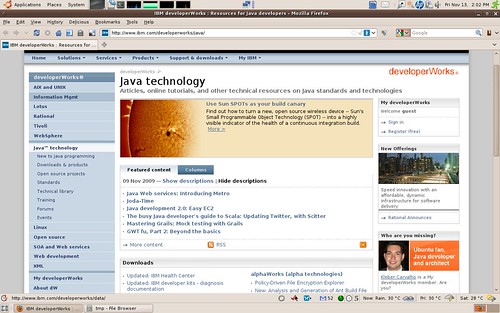When I think about grid computing I think about an application such as SETI@home. Grid computing is the application of several computers to a single problem at the same time, usually to a scientific or technical problem that requires a great number of computer processing cycles or access to large amounts of data. What distinguishes grid computing from conventional cluster computing systems is that grids tend to be more loosely coupled, heterogeneous, and geographically dispersed. Also, while a computing grid may be dedicated to a specialized application, it is often constructed with the aid of general-purpose grid software libraries and middleware.
I don’t know why I was mixing up grid computing with peer-to-peer. A peer-to-peer (or P2P) computer network uses diverse connectivity between participants in a network and the cumulative bandwidth of network participants rather than conventional centralized resources where a relatively low number of servers provide the core value to a service or application. A pure P2P network does not have the notion of clients or servers but only equal peer nodes that simultaneously function as both “clients” and “servers” to the other nodes on the network. This model of network arrangement differs from the client-server model where communication is usually to and from a central server. When I think about peer-to-peer network I keep in mind applications such as aMule for Linux, e-mule for Windows and Vuze (formerly Azureus).
Cloud computing is a style of computing in which dynamically scalable and often virtualized resources are provided as a service over the Internet. Users need not have knowledge of, expertise in, or control over the technology infrastructure “in the cloud” that supports them.The concept incorporates infrastructure as a service (IaaS), platform as a service (PaaS) and software as a service (SaaS) as well as other recent technology trends that have the common theme of reliance on the Internet for satisfying the computing needs of the users. Cloud computing services usually provide common business applications online that are accessed from a web browser, while the software and data are stored on the servers.
Cloud computing is often confused with grid computing (“a form of distributed computing whereby a ‘super and virtual computer’ is composed of a cluster of networked, loosely-coupled computers, acting in concert to perform very large tasks”), utility computing (the “packaging of computing resources, such as computation and storage, as a metered service similar to a traditional public utility such as electricity”)and autonomic computing (“computer systems capable of self-management”). When I think about cloud computing, I keep in mind companies such as IBM, Amazon, Google, Microsoft or Yahoo which are some of the major cloud computing service providers.
If you want additional information about grid computing and cloud computing I advise you read these references below:
RightScale Blog – Cloud Computing vs. Grid Computing
developerWorks – Cloud computing versus grid computing
Kleber Rodrigo de Carvalho

